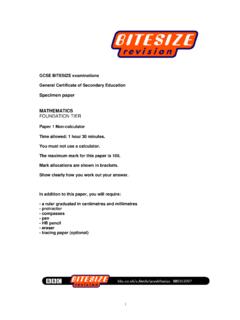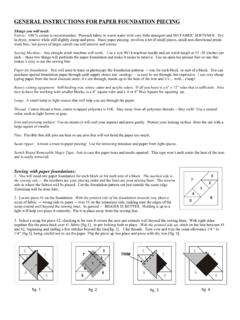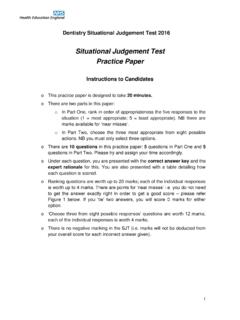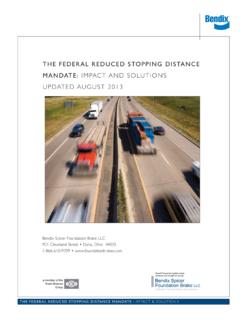Transcription of ISTQB Foundation Sample Question Paper No. 1
1 Download more Sample papers at ISTQB Foundation Sample Question Paper No. 1. 1. Deciding How much testing is enough should take into account :- i. Level of Risk including Technical and Business product and project risk ii. Project constraints such as time and budget iii. Size of Testing Team iv. Size of the Development Team a) i,ii,iii are true and iv is false b) i,,iv are true and ii is false c) i,ii are true and iii,iv are false d) ii,iii,iv are true and i is false 2. Test planning has which of the following major tasks? i. Determining the scope and risks, and identifying the objectives of testing. ii. Determining the test approach (techniques,test items, coverage, identifying and interfacing the teams involved in testing , testware). iii. Reviewing the Test Basis (such as requirements,architecture,design,interfa ce).
2 Iv. Determining the exit criteria. a) i,ii,iv are true and iii is false b) i,,iv are true and ii is false c) i,ii are true and iii,iv are false d) ii,iii,iv are true and i is false 3. Evaluating testability of the requirements and system are a part of which phase:- a) Test Analysis and Design b) Test Planning and control c) Test Implementation and execution d) Evaluating exit criteria and reporting 4. One of the fields on a form contains a text box which accepts alphabets in lower or upper case. Indentify the invalid Equivalance class value. a. CLASS. b. cLASS. c. CLass d. CLa01ss 5. In a system designed to work out the tax to be paid: An employee has 4000 of salary tax free. The next 1500 is taxed at 10% The next 28000 is taxed at 22% Any further amount is taxed at 40% Which of these groups of numbers would fall into the same equivalence class?
3 A) 4800; 14000; 28000. b) 5200; 5500; 28000. c) 28001; 32000; 35000. d) 5800; 28000; 32000. 6. Which of the following has highest level of independence in which test cases are : a) Designed by persons who write the software under test b) Designed by a person from a different section c) Designed by a person from a different organization d) Designed by another person 7. We use the output of the requirement analysis, the requirement specification as the input for writing :- Download more Sample papers at Download more Sample papers at a) User Acceptance Test Cases b) Integration Level Test Cases c) Unit Level Test Cases d) Program specifications 8. Validation involves which of the following i. Helps to check the Quality of the Built Product ii. Helps to check that we have built the right product.
4 Iii. Helps in developing the product iv. Monitoring tool wastage and obsoleteness. a) Options i,ii,iii,iv are true. b) ii is true and i,iii,iv are false c) i,ii,iii are true and iv is false d) iii is true and i,ii,iv are false. 9. Which of the following uses Impact Analysis most? a) Component testing b) Non-functional system testing c) User acceptance testing d) Maintenance testing 10. What is the expected result for each of the following test cases? A. Citibank card member, holding a Silver room B. Non Citibank-member, holding a Platinum room a) A Don't offer any upgrade, B Don't offer any upgrade. b) A Don't offer any upgrade, B Offer upgrade to Gold. c) A Offer upgrade to Silver, B Offer upgrade to Silver. d) A Offer upgrade to Gold, B Don't offer any upgrade. 11. Repeated Testing of an already tested program, after modification, to discover any defects introduced or uncovered as a result of the changes in the software being tested or in another related or unrelated software component: a) Re Testing.
5 B) Confirmation Testing c) Regression Testing d) Negative Testing 12. Impact Analysis helps to decide :-a) How much regression testing should be done. b) Exit Criteria c) How many more test cases need to written. d) Different Tools to perform Regression Testing Download more Sample papers at Download more Sample papers at 13. Functional system testing is: a) testing that the system functions with other systems b) testing that the components that comprise the system function together c) testing the end to end functionality of the system as a whole d) testing the system performs functions within specified response times 14. Consider the above state transition diagram of a switch. Which of the following represents an invalid state transition? a) OFF to ON. b) ON to OFF. c) FAULT to ON.
6 15. Peer Reviews are also called as :-a) Inspection b) Walkthrough c) Technical Review d) Formal Review 16. Consider the following statements: i. 100% statement coverage guarantees 100% branch coverage. ii. 100% branch coverage guarantees 100% statement coverage. iii. 100% branch coverage guarantees 100% decision coverage. iv. 100% decision coverage guarantees 100% branch coverage. v. 100% statement coverage guarantees 100% decision coverage. a) ii is True; i, iii, iv & v are False b) i & v are True; ii, iii & iv are False c) ii & iii are True; i, iv & v are False d) ii, iii & iv are True; i & v are False 17. The Kick Off phase of a formal review includes the following :- a) Explaining the objective b) Fixing defects found typically done by author c) Follow up d) Individual Meeting preparations 18.
7 Match every stage of the software Development Life cycle with the Testing Life cycle:i. Hi-level design a Unit tests ii. Code b Acceptance tests iii. Low-level design c System tests iv. Business requirements d Integration tests a) i-d , ii-a , iii-c , iv-b b) i-c , ii-d , iii-a , iv-b c) i-b , ii-a , iii-d , iv-c d) i-c , ii-a , iii-d , iv-b 19. Which of the following is not phase of the Fundamental Test Process?a) Test Planning and Download more Sample papers at Download more Sample papers at Control b) Test implementation and Execution c) Requirement Analysis d) Evaluating Exit criteria and reporting 20. Which of the following techniques is NOT a black box technique? a) State transition testing b) LCSAJ (Linear Code Sequence and Jump). c) syntax testing d) boundary value analysis 21.
8 Success Factors for a review include : i. Each Review does not have a predefined objective ii. Defects found are welcomed and expressed objectively iii. Management supports a good review process. iv. There is an emphasis on learning and process improvement. a) ii,iii,iv are correct and i is incorrect b) iii , i , iv is correct and ii is incorrect c) i , iii , iv , ii is in correct d) ii is correct 22. Defects discovered by static analysis tools include : i. Variables that are never used. ii. Security vulnerabilities. iii. Programming Standard Violations iv. Uncalled functions and procedures a) i , ii,iii,iv is correct b) iii ,is correct I,ii,iv are incorrect. c) i ,ii, iii and iv are incorrect d) iv, ii is correct 23. Test Conditions are derived from :- a) Specifications b) Test Cases c) Test Data d) Test Design 24.
9 Which of the following is true about White and Black Box Testing Technique:- a) Equivalance partitioning, Decision Table and Control flow are White box Testing Techniques. b) Equivalence partitioning , Boundary Value Analysis , Data Flow are Black Box Testing Techniques. c) Equivalence partitioning , State Transition , Use Case Testing are black box Testing Techniques. d) Equivalence Partioning , State Transition , Use Case Testing and Decision Table are White Box Testing Techniques. 25. Regression testing should be performed: i. every week ii. after the software has changed iii. as often as possible iv. when the environment has changed v. when the project manager says a) i & ii are true, iii, iv & v are false b) ii, iii & iv are true, i & v are false c) ii & iv are true, i, iii & v are false Download more Sample papers at Download more Sample papers at d) ii is true, i, iii, iv & v are false 26.
10 Benefits of Independent Testing a) Independent testers are much more qualified than Developers b) Independent testers see other and different defects and are unbiased. c) Independent Testers cannot identify defects. d) Independent Testers can test better than developers 27. Minimum Tests Required for Statement Coverage and Branch Coverage :-Read P. Read Q. If p+q > 100 then Print Large . End if If p > 50 then Print pLarge . End if a) Statement coverage is 2, Branch Coverage is 2. b) Statement coverage is 3 and branch coverage is 2. c) Statement coverage is 1 and branch coverage is 2. d) Statement Coverage is 4 and Branch coverage is 2. 28. Minimum Test Required for Statement Coverage :-Disc = 0. Order-qty = 0. Read Order-qty If Order-qty >=20 then Disc = If Order-qty >=100 then Disc = End if End if a) Statement coverage is 4.






